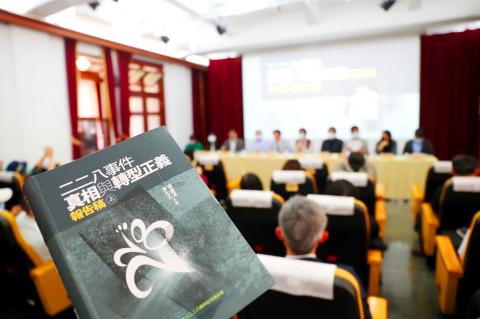A new book shedding light on the atrocities committed by the Chinese Nationalist Party (KMT) during the 228 Massacre was launched by the 228 Memorial Foundation yesterday
The book, titled The Truth About the 228 Incident and Transitional Justice Reports (二二八事件真相與轉型正義報告稿) is a follow-up to The 228 Incident: A Report on Responsibility (二二八事件責任歸屬研究報告), which was released 14 years ago and named former president Chiang Kai-shek (蔣介石) as the main culprit.
The 228 Massacre refers to a crackdown launched by the then-KMT regime against civilian demonstrators following an incident in Taipei on Feb. 27, 1947.

Photo: CNA
The massacre was a tragedy caused by state violence in the form of military suppression, and was filled with “illegitimacy and abuses of power,” as well as “unauthorized actions and a state of anarchy,” the new book said.
However, most military personnel that took part in the suppression were not held accountable, it said, adding that Chiang, who covered up, rewarded, or even promoted the perpetrators, is one of the main culprits behind the tragedy.
Part of the crackdown was launched by the Nationalist Army’s navy, including a political purge at Kaohsiung’s Zuoying oil refinery, where soldiers pillaged valuable items and shot some of the workers, it added.
Chiang deployed five naval vessels to boost the troops in Kaohsiung, the book said.
About two weeks into the massacre, military police departments became the government’s intelligence agencies, which carried out summary executions of political dissidents, it said.
Su Yao-tsung (蘇瑤崇), a Providence University professor who coauthored the book, said that fewer than 45 waishengren (外省人) were injured during the crackdown, adding that many of the books about the period have “exaggerated” the number of waishengren victims.
Inaccurate reporting, such as by the Central Daily News (中央日報), the mouthpiece of the then-KMT regime, which claimed that more than 400 waishengren were injured, was used to sow fear among the public and bolster the party’s authoritarian rule, Su said.
Academia Historica editor Ou Su-ing (歐素瑛), another coauthor, said that some regional heads were also culprits in the violence, including then-Hsinchu mayor Kuo Shao-tsung (郭紹宗), Chiayi mayor Sun Chih-chun (孫志俊) and Pingtung mayor Kung Lu-tuan (龔履端).
These officials were strongly opposed to the committees established by prominent residents to deal with the massacre’s aftermath — or sent troops to crack down on them, as they feared that the existence of military agencies in their jurisdiction would put them at a disadvantage, she said.
Fifteen out of 17 regional heads at the time were waishengren, and the other two — then-Taipei mayor Yu Mi-chien (游彌堅) and Kaohsiung mayor Huang Chung-tu (黃仲圖) — were benshengren (本省人) who had connections to China, Ou said.
Most of them were KMT members and considered unfit by local residents, while some had worked under then-Taiwan governor Chen Yi (陳儀).
Foundation chairman Hsueh Hua-yuan (薛化元) said that truth is essential for transitional justice, but that a great deal of information still needs to be uncovered.

The CIA has a message for Chinese government officials worried about their place in Chinese President Xi Jinping’s (習近平) government: Come work with us. The agency released two Mandarin-language videos on social media on Thursday inviting disgruntled officials to contact the CIA. The recruitment videos posted on YouTube and X racked up more than 5 million views combined in their first day. The outreach comes as CIA Director John Ratcliffe has vowed to boost the agency’s use of intelligence from human sources and its focus on China, which has recently targeted US officials with its own espionage operations. The videos are “aimed at

STEADFAST FRIEND: The bills encourage increased Taiwan-US engagement and address China’s distortion of UN Resolution 2758 to isolate Taiwan internationally The Presidential Office yesterday thanked the US House of Representatives for unanimously passing two Taiwan-related bills highlighting its solid support for Taiwan’s democracy and global participation, and for deepening bilateral relations. One of the bills, the Taiwan Assurance Implementation Act, requires the US Department of State to periodically review its guidelines for engagement with Taiwan, and report to the US Congress on the guidelines and plans to lift self-imposed limitations on US-Taiwan engagement. The other bill is the Taiwan International Solidarity Act, which clarifies that UN Resolution 2758 does not address the issue of the representation of Taiwan or its people in

US Indo-Pacific Commander Admiral Samuel Paparo on Friday expressed concern over the rate at which China is diversifying its military exercises, the Financial Times (FT) reported on Saturday. “The rates of change on the depth and breadth of their exercises is the one non-linear effect that I’ve seen in the last year that wakes me up at night or keeps me up at night,” Paparo was quoted by FT as saying while attending the annual Sedona Forum at the McCain Institute in Arizona. Paparo also expressed concern over the speed with which China was expanding its military. While the US

SHIFT: Taiwan’s better-than-expected first-quarter GDP and signs of weakness in the US have driven global capital back to emerging markets, the central bank head said The central bank yesterday blamed market speculation for the steep rise in the local currency, and urged exporters and financial institutions to stay calm and stop panic sell-offs to avoid hurting their own profitability. The nation’s top monetary policymaker said that it would step in, if necessary, to maintain order and stability in the foreign exchange market. The remarks came as the NT dollar yesterday closed up NT$0.919 to NT$30.145 against the US dollar in Taipei trading, after rising as high as NT$29.59 in intraday trading. The local currency has surged 5.85 percent against the greenback over the past two sessions, central